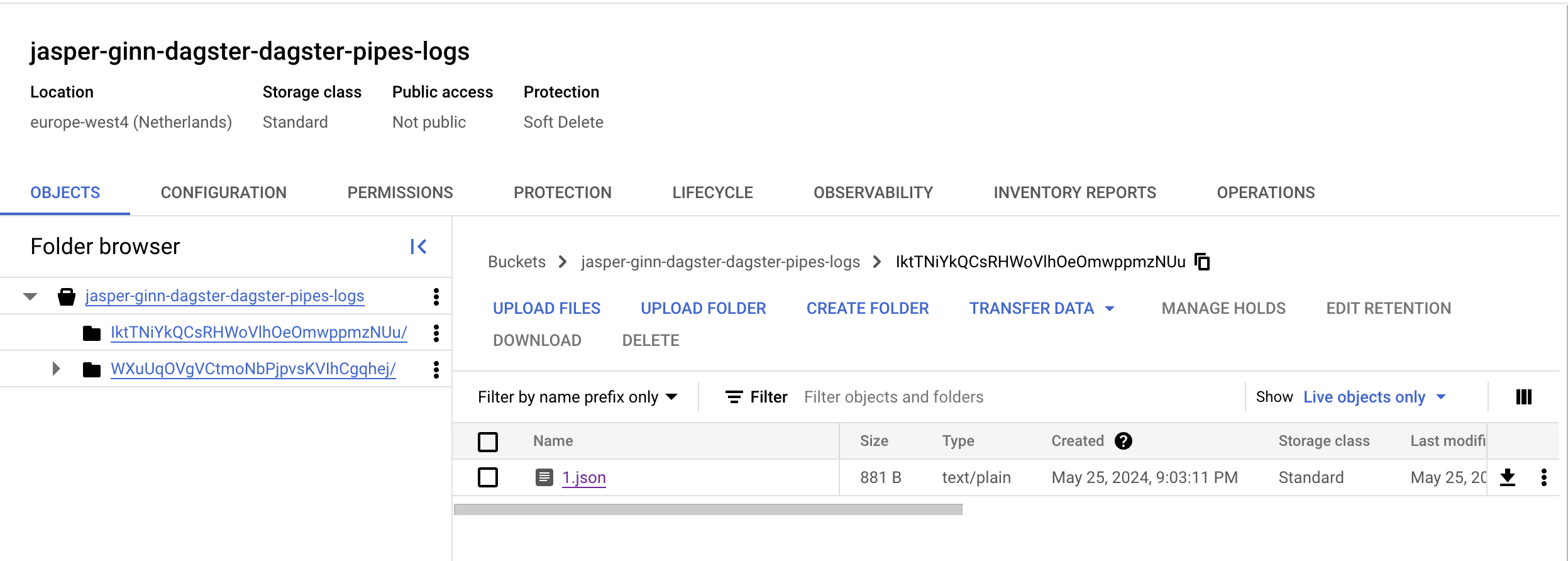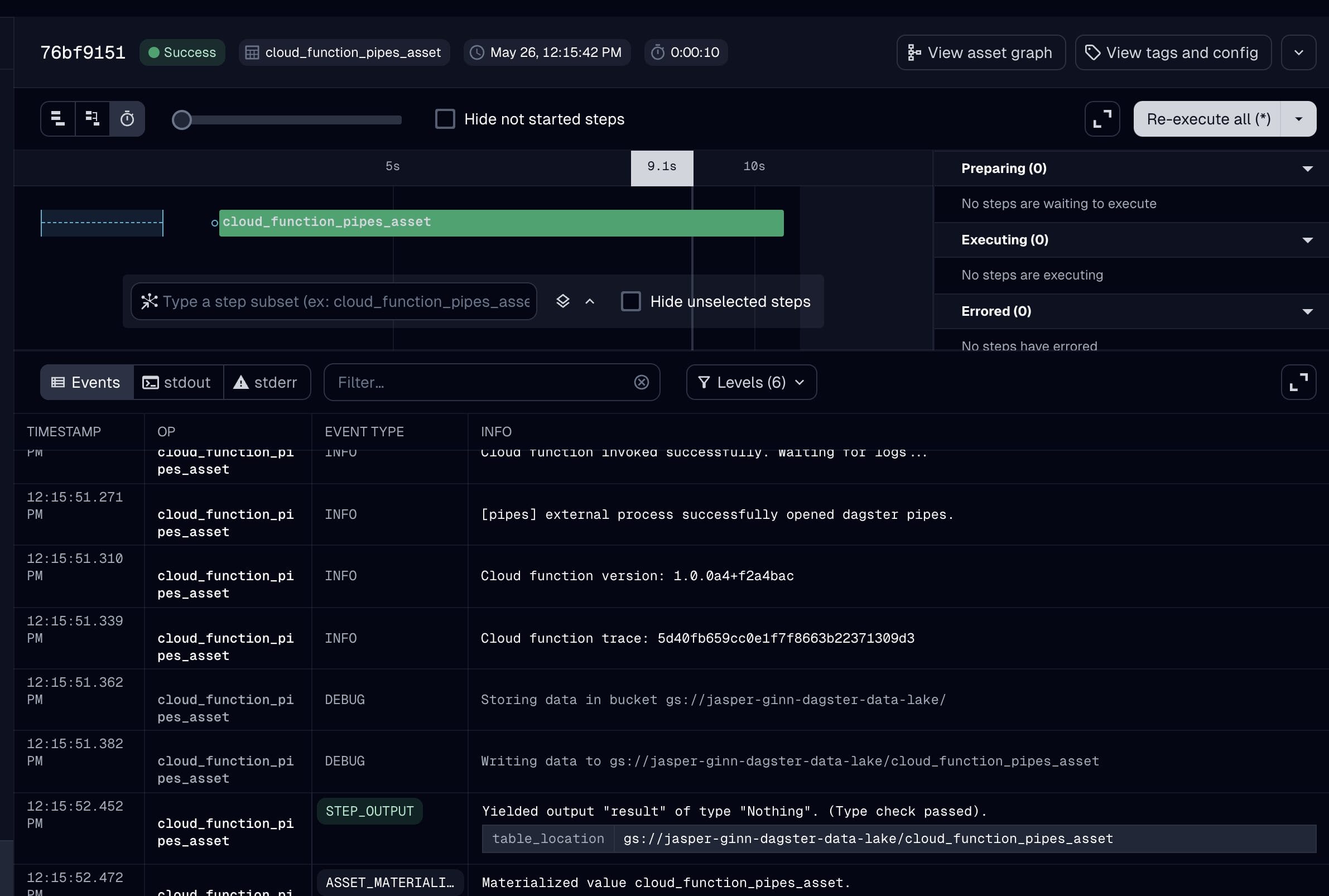Blog
How to use Dagster to orchestrate Google Cloud Functions (or any other external execution environment)

I know, right? This should be a trivial task; you have some existing code deployed on, say, a Google Cloud Function, and you want Dagster to orchestrate it. This is easy to do in e.g. Airflow, but Dagster only recently added this functionality through the dagster-pipes library:
Dagster Pipes is a toolkit for building integrations between Dagster and external execution environments. It standardizes the process of passing parameters, injecting context information, ingesting logs, and collecting metadata all while remaining agnostic to how remote computations are launched in those environments. This enables the separation of orchestration and business logic in the Dagster ecosystem.
Neat! This enables us to run business logic in any execution environment. Given that there's no official integration with Google Cloud services as of yet, we'll put the dagster-pipes library to the test by extending it to use Google Cloud Functions as an external execution environment.
⚒️ Setting up
The code for this post can be found on GitHub. If you're following along, then use the instructions in the README to set up your environment.
The repository contains two folders with python code:
- dagster: this contains the source code of the Dagster DAG. We will run this locally. When we materialize the asset that uses the cloud function, the asset should make a call to the cloud function so that our business logic executes. When the cloud function completes, we will then ingest logs generated by the external execution environment so that they show up in the dagster UI.
- cloud_function: this contains the source code of the cloud function (our external execution environment). This function should take input parameters and contextual information (e.g. asset name) from the orchestrator, run our business logic, and write logs to a suitable location where they can be picked up by the orchestrator.
For this implementation, I've leaned heavily on the dagster-pipes AWS Lambda implementation and the dagster-pipes source code.
☁️ The cloud function
There's a couple of things that we need here:
- The actual business logic. We'll generate some fake data and write it to a delta table on cloud storage.
- A custom
message writerthat will capture logs, metadata, and events generated in the execution environment and put them somewhere for the orchestrator to pick up.
Implementing the cloud function
If you've worked with cloud functions previously, then the setup should look familiar to you. We have an entry point ('main') that takes a flask.Request input. From the request, we can parse the trace id and retrieve any inputs and contextual information that the orchestrator passed to the execution environment. In turn, these are used as inputs for the open_dagster_pipes context manager.
For example:
- The orchestrator passed the input 'dl_bucket' and we can access it using
event["dl_bucket"]. - We use
pipes.asset_keyto retrieve the name of the asset in the orchestration service. - We report back the asset table location by specifying this as metadata in the
pipes.report_asset_materializationmethod.
def main(request: flask.Request):
event = request.get_json()
trace_header = request.headers.get("X-Cloud-Trace-Context") or "local"
trace = trace_header.split("/")[0]
with open_dagster_pipes(
params_loader=PipesMappingParamsLoader(event),
message_writer=PipesCloudStorageMessageWriter(
client=google.cloud.storage.Client(),
),
) as pipes:
pipes.log.info(f"Cloud function version: {__version__}")
pipes.log.info(f"Cloud function trace: {trace}")
dl_bucket = event["dl_bucket"]
pipes.log.debug(f"Storing data in bucket {dl_bucket}")
table_location = f"{dl_bucket}/{pipes.asset_key}"
pipes.log.debug(f"Writing data to {table_location}")
df = get_fake_data()
df.write_delta(table_location, mode="append")
pipes.report_asset_materialization(
metadata={"table_location": table_location},
data_version="alpha",
)
# Force the context to be reinitialized on the next request
# see: https://github.com/dagster-io/dagster/issues/22094
PipesContext._instance = None
return "OK", 200
Contrary to what you might expect, this does not open up a direct connection between the orchestrator and the execution environment. All communication back to the orchestrator is handled by the message_writer, which is of a custom class called PipesCloudStorageMessageWriter.
Essentially, all this message writer class does is to return a channel whose job it is to capture any events and logs while the open_dagster_pipes context manager is active and write these to cloud storage so that the orchestrator process can download these later.
class PipesCloudStorageMessageWriterChannel(PipesBlobStoreMessageWriterChannel):
def __init__(
self,
client: google.cloud.storage.Client,
bucket: str,
key_prefix: Optional[str],
*,
interval: float = 10,
):
super().__init__(interval=interval)
self._client = client
self._bucket = client.bucket(bucket)
self._key_prefix = key_prefix
def upload_messages_chunk(self, payload: IO, index: int) -> None:
key = f"{self._key_prefix}/{index}.json" if self._key_prefix else f"{index}.json"
blob = self._bucket.blob(key)
blob.upload_from_string(payload.read())
An important feature of the message writer is that it is paired with a message reader (see below) implementation in the orchestrator process. The message reader is responsible for defining the variables 'bucket' and 'key_prefix'. The orchestrator then injects these variables in the context and sends them to the execution environment, which is how we can retrieve them here:
...
bucket = _assert_env_param_type(params, "bucket", str, self.__class__)
key_prefix = _assert_opt_env_param_type(params, "key_prefix", str, self.__class__)
...
If we materialize our asset at this point, then you should see these logs popping up in cloud storage:

The orchestrator
The orchestration logic looks like normal Dagster code; we define an asset definition that uses a resource, and set up a code location using an Definitions object:
@asset(
description="A cloud function that writes fake data to a delta table.",
)
def cloud_function_pipes_asset(
context: AssetExecutionContext, pipes_function_client: PipesCloudFunctionClient
) -> MaterializeResult:
return pipes_function_client.run(
context=context,
# function_url="http://127.0.0.1:8080",
function_url="https://europe-west4-jasper-ginn-dagster.cloudfunctions.net/dagster-pipes-gcp-nprod",
event={
"dl_bucket": "gs://jasper-ginn-dagster-data-lake/",
},
).get_materialize_result()
defs = Definitions(
assets=[cloud_function_pipes_asset],
resources={
"pipes_function_client": PipesCloudFunctionClient(
message_reader=PipesCloudStorageMessageReader(
bucket="jasper-ginn-dagster-dagster-pipes-logs",
client=google.cloud.storage.Client(),
)
)
},
)
In the above code: - We use a custom PipesBlobStoreMessageReader to read logs from the cloud storage bucket. - We use a custom PipesClient resource. This resource is responsible for parsing e.g. the dagster AssetExecutionContext, environment variables, and the request data, and then passing these to the classes and functions that trigger the cloud function and load the logs.
Let's pick these pieces apart one by one.
The PipesBlobStoreMessageReader
This class is responsible for reading logs that were written to cloud storage by the 'message writer' (see above). The important bit in this class is the download_messages_chunk method. This method retrieves the logs stored as JSON entries in a cloud storage bucket. If the entry doesn't exist, it returns None, which is how the reader knows it's finished.
def download_messages_chunk(self, index: int, params: PipesParams) -> Optional[str]:
key = f"{params['key_prefix']}/{index}.json"
bucket = self.client.bucket(self.bucket)
blob = bucket.blob(key)
if blob.exists():
return blob.download_as_text()
else:
return None
The PipesClient
The PipesClientis responsible for parsing e.g. the dagster AssetExecutionContext, environment variables, and the request data, and then passing these to the classes and functions that trigger the cloud function and load the logs. The important bit of code in the PipesClient comes down to constructing the request data and invoking the cloud function:
...
if isinstance(self._context_injector, PipesCloudFunctionEventContextInjector):
payload_data = {
**event,
**session.get_bootstrap_env_vars(),
}
else:
payload_data: Mapping[str, Any] = event # type: ignore
response = invoke_cloud_function(
url=function_url,
data=payload_data,
)
...
There's a fair amount of things happening in the background here, but what's important to note is that the session.get_bootstrap_env_vars method puts all the context information that is stored in the asset's AssetExecutionContext and any other pipeline parameters in a event payload and sends this to the cloud function.
Recall that in the cloud function message writer, we used this bit of code to get the bucket and key_prefix when writing logs to cloud storage:
...
bucket = _assert_env_param_type(params, "bucket", str, self.__class__)
key_prefix = _assert_opt_env_param_type(params, "key_prefix", str, self.__class__)
...
These two parameters are also injected into the payload by the session.get_bootstrap_env_vars method, which is why we can access them in the cloud function. In turn, these two variables are defined in the PipesCloudStorageMessageReader class through its get_params method:
@contextmanager
def get_params(self) -> Iterator[PipesParams]:
key_prefix = "".join(random.choices(string.ascii_letters, k=30)) # nosec
yield {"bucket": self.bucket, "key_prefix": key_prefix}
Note that, while we have to invoke the call to the cloud function, we don't necessarily have to do this to retrieve logs. When the PipesClient.run method completes, it returns a PipesClientCompletedInvocation class. This class will then call the appropriate function to download logs using the message reader class.
✨ Materializing the asset
We should now be able to materialize the asset and retrieve the logs from the external execution environment. Execute just dd to spin up the dagster webserver and materialize the asset!

As you can see, the asset was materialized, and the metadata and logs were then collected by dagster and are available in the UI.
Ceci n’est pas une pipe
The functionality provided by the 'dagster-pipes' library is a useful feature that allows users to orchestrate services in external execution environments. In this post, we extended the library by adding Google Cloud Functions as an external execution environment. If you're interested in adding your own external execution environment, then check out the documentation.
Image generated with Dreamstudio
Written by

Jasper Ginn
Our Ideas
Explore More Blogs

AI in Healthcare: Trends, Strategies, and Barriers Shaping Healthcare in 2026...
Katarzyna Kusznierczuk
Contact


